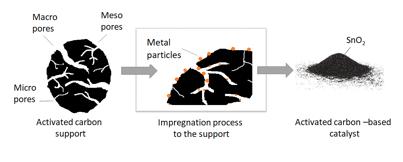
4 minute read
2.2.2 RESULTS
Scheme 1. Representation of O-methylation with the alkylating agents dimethyl sulphate and dimethyl carbonate
Four different alkylating agents were used, of which three added a methyl group comprising one carbon and three hydrogens and one adding an ethyl group, comprising two carbons and five hydrogens, see Figure 17 below. In brief, the hydrolysis lignin was dissolved in a solvent together with the alkylating agent. For two of the alkylating agents, the solution was heated to increase the reaction speed. The reactions were terminated by lowering the pH which caused the hydrolysis lignin to precipitate. The lignin precipitate could then be filtered, washed with water until the washings had neutral pH and then left to dry in room temperature. The elemental composition of the samples was analysed via elemental analysis determining the concentration of C, N, H in the sample and calculating O concentration based on the other three elements.
Advertisement
Figure 17. Methyl group (left) and ethyl group (right)
The enzymatic hydrolysis lowered the sugar content in the hydrolysis lignin and thereby resulted in an increase in klason lignin.
Washing of hydrolysis lignin
All attempts to wash hydrolysis lignin with an organic solvent were unsuccessful. The hydrolysis lignin was either insoluble in the solvents or partly soluble resulting in fractionation of the hydrolysis lignin. In the latter case, one organic solvent soluble fraction and one organic solvent insoluble fraction was obtained. The hydrolysis lignin also turned darker after some washings, see Figure 18.
Figure 18. Hydrolysis lignin after washings with the moderately polar solvent tetrahydrofuran
The washings using acids or bases did not significantly improve the content of klason lignin in the samples, see Figure 19 below. The largest increase in klason content was observed in the experiment where the hydrolysis lignin was washed with 0.1 M NaOH at 90°C for 10 minutes. A small increase was also noticed for washing with acid. The low klason yields for the ethyl acetate washing may be caused by the insolubility and immiscibility of hydrolysis lignin in the organic solvent, i.e. as discussed above.

Figure 19. Klason content (%) after washing with acids (H2SO4), base (NaOH) and organic solvent (EA=ethyl acetate) at different reaction conditions
Figure 20. Wt % yields of ozone oxidized hydrolysis lignin at different reaction parameters as indicated by the labels in the figure
Oxidation of hydrolysis lignin
The yield of oxidized hydrolysis lignin was positively correlated to reaction time and flow rate of the ozone, see Figure 20 below. Increasing the temperature from room temperature to 50°C for 30 minutes resulted in a 32% (w/w) increase in the yield. However, it was challenging to control the flow of ozone and furthermore, the required solvent is relatively expensive which could be limiting factor for scaling up.

Analysis via size exclusion chromatography confirmed that the ozone oxidized hydrolysis lignin had been subject to depolymerisation or degradation during the oxidation reaction, i.e. the molecules were smaller than in the starting material, Figure 21. The smaller molecular size resulted in a longer retention time which is observed in the figure below.
In contrast to the oxidation experiments with ozone, increasing reaction time and temperature for hydrogen peroxide mediated oxidation resulted in a decrease in oxidation yield, Figure 22 and Figure 23. This observation may be attributed to excessive oxidation and depolymerisation, i.e. degradation as was observed for the ozone oxidized hydrolysis lignin. Decreasing the hydrogen peroxide concentration, i.e. changing hydrogen peroxide to lignin ratio, resulted in a significant increase in yield, Figure 23 and Figure 24.

Figure 21. Size exclusion chromatogram of starting hydrolysis lignin (RA-SM) and oxidized hydrolysis lignin produced using an ozone flow of 3 mL/s for 1h and then heated at 50 oC for half an hour.
Figure 22. Oxidation yield of hydrolysis lignin as a function of reaction temperature under constant concentration of hydrogen peroxide as oxidizing agent
Figure 23. Oxidation yield of hydrolysis lignin as a function of reaction time and lignin to hydrogen peroxide ratio, i.e. hydrogen peroxide concentration at 15°C (left) and room temperature (right)
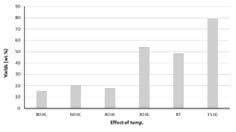
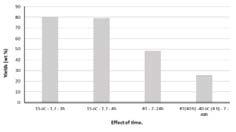
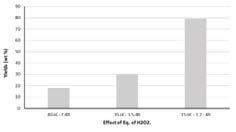
Figure 24. Yield of hydrogen peroxide oxidized hydrolysis lignin under varying temperature and lignin to hydrogen peroxide ratio, 7, 3.5 and 1.7, respectively
To summarize, milder reaction conditions are preferred to preserve the original structure of the hydrolysis lignin. However, one can tune the conditions to depolymerization/degradation. Furthermore, we propose the utilization of hydrogen peroxide as oxidizing agent instead of ozone. For comparison, native and oxidized hydrolysis lignin in shown in Figure 25 below.
Figure 25. Hydrolysis lignin before (left) and after oxidation (right)
Functionalization of hydrolysis lignin
The yields of the alkylation experiments were in the range of 7,9-31,0% (w/w). Different reaction conditions, e.g. reaction temperature and alkylating agent make comparisons challenging. However, elemental analysis confirm that the reactions were successful, as indicated by an increase in carbon content and a decrease in oxygen content, Table 3.
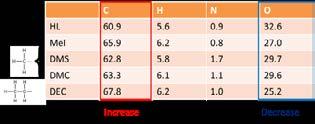
Table 3. Elemental composition (wt%) of hydrolysis lignin before and after alkylations



